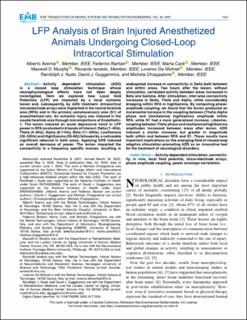| dc.contributor.author | Averna, Alberto | |
| dc.contributor.author | Barban, Federico | |
| dc.contributor.author | Care, Marta | |
| dc.contributor.author | Murphy, Maxwell D. | |
| dc.contributor.author | Iandolo, Riccardo | |
| dc.contributor.author | De Michieli, Lorenzo | |
| dc.contributor.author | Nudo, Randolph J. | |
| dc.contributor.author | Guggenmos, David J. | |
| dc.contributor.author | Chiappalone, Michela | |
| dc.date.accessioned | 2023-09-13T09:24:19Z | |
| dc.date.available | 2023-09-13T09:24:19Z | |
| dc.date.created | 2022-08-31T15:11:04Z | |
| dc.date.issued | 2022 | |
| dc.identifier.citation | IEEE transactions on neural systems and rehabilitation engineering. 2022, 30 1441-1451. | en_US |
| dc.identifier.issn | 1534-4320 | |
| dc.identifier.uri | https://hdl.handle.net/11250/3089098 | |
| dc.description.abstract | Activity dependent stimulation (ADS) is a closed loop stimulation technique whose neurophysiological effects have not been deeply investigated. Here we explored how Local field Potentials (LFP) are impacted by a focal ischemic lesion and, subsequently, by ADS treatment. Intracortical microelectrode arrays were implanted in the rostral forelimb area (RFA) and in the primary somatosensory area (S1) of anaesthetized rats. An ischemic injury was induced in the caudal forelimb area through microinjections of Endothelin-1. The lesion induced an acute depressive trend in LFP power in RFA (evaluated in 6 bands of interest: Delta (1–4Hz), Theta (4–8Hz), Alpha (8-11Hz), Beta (11–30Hz), LowGamma (30–55Hz) and HighGamma (55-80)) followed by a noticeable significant rebound in both areas. Applying ADS induced an overall decrease of power. The lesion impacted the connectivity in a frequency specific manner, resulting in widespread increase in connectivity in Delta both between and within areas. Two hours after the lesion, without stimulation, correlated activity between areas increased in Beta and Gamma. After stimulation, inter-area connectivity increased in Delta, Theta and Alpha, while considerably dropping within RFA in highGamma. By computing phase-amplitude coupling, we found that the lesion produced an incremental increase in the coupling between (Theta) Alpha phase and (lowGamma) highGamma amplitude within RFA, while S1 had a more generalized increase. Likewise, coupling between Theta phase and lowGamma/highGamma amplitudes increased between areas after lesion. ADS induced a similar increase, but greater in magnitude both within and between RFA and S1. These results have important implications on the emerging field of closed-loop adaptive stimulation promoting ADS as an innovative tool for the treatment of neurological disorders. | en_US |
| dc.language.iso | eng | en_US |
| dc.publisher | IEEE | en_US |
| dc.rights | Navngivelse 4.0 Internasjonal | * |
| dc.rights.uri | http://creativecommons.org/licenses/by/4.0/deed.no | * |
| dc.title | LFP Analysis of Brain Injured Anesthetized Animals Undergoing Closed-Loop Intracortical Stimulation | en_US |
| dc.title.alternative | LFP Analysis of Brain Injured Anesthetized Animals Undergoing Closed-Loop Intracortical Stimulation | en_US |
| dc.type | Peer reviewed | en_US |
| dc.type | Journal article | en_US |
| dc.description.version | publishedVersion | en_US |
| dc.source.pagenumber | 1441-1451 | en_US |
| dc.source.volume | 30 | en_US |
| dc.source.journal | IEEE transactions on neural systems and rehabilitation engineering | en_US |
| dc.identifier.doi | 10.1109/TNSRE.2022.3177254 | |
| dc.identifier.cristin | 2047657 | |
| cristin.ispublished | true | |
| cristin.fulltext | original | |
| cristin.qualitycode | 2 | |

